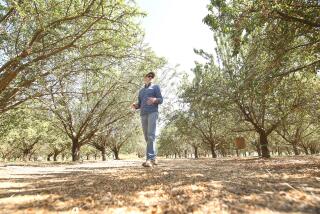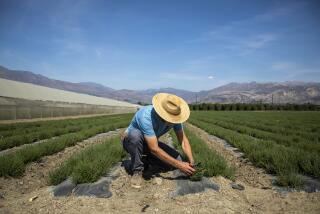Farmers’ lack of bees might be solved by going wild
Farmers who have watched helplessly as a mysterious disease wiped out millions of domesticated bees needed to pollinate their almonds, apples and other crops may have an easy solution: make their crops more accessible to wild insects that do the job for free.
Not only are they cheaper, they fertilize blossoms with much greater efficiency, new research shows. After observing bees in hundreds of fields on multiple continents, scientists calculated that free-living bees were twice as effective as domesticated honeybees at prompting flowers to produce fruit. In addition, the proportion of flowers that matured to fruit improved in every field visited by wild insects, compared with only 14% of fields visited by rented honeybees, according to a report published online Thursday by the journal Science.
The findings have important implications for agricultural and land-use policies worldwide, said study leader Lucas A. Garibaldi, an agricultural scientist at the National University of Rio Negro in Argentina: Unless habitats for wild insects are protected and nurtured, farmers around the world could face a future of drastically lower yields.
Scientists have long warned that plowing landscapes into vast, single-crop fields and orchards eliminates the range of soil, wildflowers and other vegetation that is crucial to support multiple species of wild pollinators, including bees, flies, beetles and butterflies. As these insect populations have dwindled, farmers have resorted to using rented interlopers, generally Apis mellifera, during flowering season.
“Honeybees cannot replace the service wild bees provide,” Garibaldi said. “Biodiversity in agricultural landscapes matters and can help increase production.”
Garibaldi and his colleagues from North and South America, Europe, Australia, Africa and the Middle East analyzed data that had been collected in earlier studies based on direct observation of insect activity in small swaths of 600 fields in 19 countries. Researchers generally counted insects, flowers and pollen grains over varying periods of time on crops that represented different landscapes and management techniques. Some fields were heavily dependent on domesticated bees; in others, wild insects prevailed.
Even in fields dominated by domesticated bees, farmers often get more effective pollination services from native insects, said study coauthor Rachael Winfree, a pollination ecologist at Rutgers University in New Brunswick, N.J.
“At 90% of farms studied in New Jersey and Pennsylvania, native wild bees are fully pollinating the watermelon crop,” making rented bees unnecessary, Winfree said. But farmers don’t realize this. “They’re thinking they need them but they don’t,” she said.
In California, the $3-billion almond industry spends $239 million annually to rent more than 1 million bee hives every year. To get that many pollinators, growers have been renting honeybees — an increasingly expensive practice as colony collapse disorder wipes out bees by the millions, for reasons that remain poorly understood.
In some California orchards, the data showed that pollination by rented honeybees got a significant boost when wild bees were present, possibly because the wild insects prompted the hired guns to fly more frequently among different varieties of trees in an orchard, said Claire Kremen, a UC Berkeley conservation biologist who contributed to the study.
However, she noted that most almond fields don’t receive that benefit because habitat for wild insects has been destroyed.
Laurence Packer, who studies wild bees at York University in Toronto and wasn’t involved with the new report, praised the work for its breadth and geographical scope. The findings are important and should be taken seriously, he said.
“Honeybees aren’t all they’re cracked up to be,” Packer said. “Other bees are far more important than people thought.”







